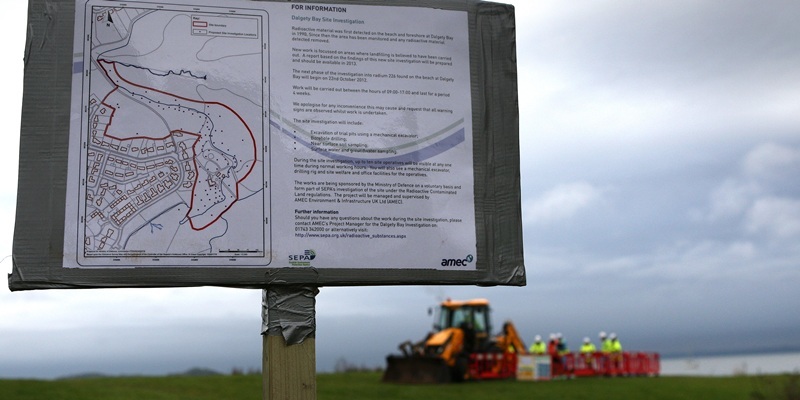Anger over the Minstry of Defence’s handling of radiation at a Fife beach threatened to boil over at the latest meeting held to discuss the situation.
SEPA also announced that it will be establishing a group of independent experts in radioactivity to help provide advice and guidance on the contamination at Dalgety Bay.
Local councillor Alice McGarry welcomed SEPA’s call for the MoD to come up with a remediation plan and accept responsibility for paying for the clear-up.
She also expressed her anger at the MoD’S apparent failure to accept liability for the original dumping of radioactive material and its refusal to fund a temporary barrier if one was considered necessary to prevent further erosion and uncovering of radioactive materials.
”I was livid at the MoD’s attitude but at least it’s come down to the wire now, and if there’s no remediation plan in place by March we’re going to go down the route of designation of land,” she said.
”The MoD are still playing this game where they are not accepting responsibility, saying ‘it might not have been us’, but they’ve had 21 years to do something.
”Folk really have had enough and people want the MoD to come up with some action whether that’s removal or encapsulation.”
Cowdenbeath MSP Helen Eadie spoke of her ”disappointment” at the meeting, saying the MoD’s reaction ”’left a great deal to be desired” and ”smacked of dither and delay”.
Mrs Eadie said: ”The Ministry of Defence may talk about progress but their actions do not show the signs of urgency that I would expect considering the situation.
”The plan brought forward by SEPA is perfectly reasonable and the MoD needs to start delivering. There have been not enough signs of progress and people want concrete action taken.
”For too long they have come up with barriers to progress rather than helping to deliver solutions.”
Dalgety Bay Community Council chairman Colin McPhail said he felt the draft plan brought forward by SEPA appeared to be a decent way forward.
”The Ministry of Defence should be prepared to adopt it and also adhere to the timescales suggested,” he said. ”There is a real urgency in this situation and everyone involved need to recognise that.”
An MoD spokesman said: ”The MoD has assisted SEPA in every way possible to date and we have reached an agreed way forward to work together to inform the position as to where any potential liability lies.”
Amid growing concern about the particles that continue to be found on the foreshore at Dalgety Bay, scientists from the Scottish Environment Protection Agency (SEPA) advised members of the Dalgety Bay Forum at a meeting in Stirling on Tuesday of further findings of highly radioactive material.
The presence of radiation at the shore has been public knowledge since 1990, although the quiet coastal commuter town has hit the headlines in recent months after a lump of contaminated metal 10 times more radioactive than anything previously found in the area was dug up.
It is thought the contamination comes from residue of radium-coated instrument panels used on military aircraft, which were incinerated and land-filled in the area at the end of the Second World War.
But with more particles being found as investigations continue, SEPA has given the MoD until the end of February to put a credible long-term remediation plan in place or face the prospect of legal action which could see an area around the foreshore designated Radioactive Contaminated Land (RCL) for the public’s protection.
Dr Paul Dale, SEPA principal policy officer, reported that further work was carried out at the weekend to remove more radioactive sources from the beach, three of which were deemed to be ”high activity” sources.
Worryingly, one of those gave what Dr Dale described as an ”extremely high” in-field reading of 76MBq (Megabecquerels), with the others measuring 3.6MBq and 4.5MBq. These have been removed to a laboratory and are being analysed.
Dr Dale said: ”SEPA believes that the Ministry of Defence is responsible for the radioactive material present at Dalgety Bay, and as such Defence Infrastructure Organisation (DIO) is the responsible party in terms of remediation.
”SEPA will continue to work constructively and cooperatively with DIO, but as the regulator SEPA has a specific role under the Radioactive Contaminated Land regulations to assess the fitness of the proposals of the responsible party for the protection of the environment and human health.
”SEPA will continue with the necessary preparations for designation of the area as RCL in the event that it does not receive a credible long-term voluntary remediation plan from DIO.
”We expect to see a draft of the remediation plan by the end on January 2012, and to have the final version by the end of February.
”If this does not happen, SEPA intends to designate the area as RCL by the end of March 2012.”
Dr Dale went on to say that if a voluntary remediation plan is in place by the end of February 2012, designation would no longer be required.
Continued…
